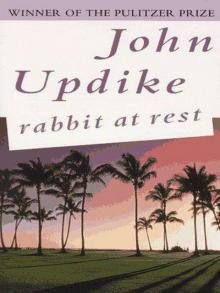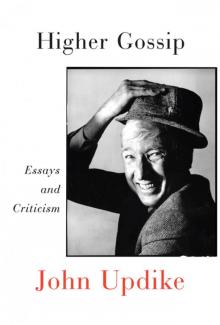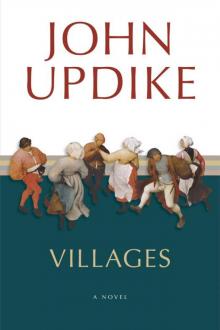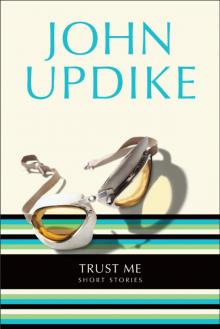- Home
- John Updike
Picked-Up Pieces Page 4
Picked-Up Pieces Read online
Page 4
Dr. Johnson defined “novel” as a type of tale; and, though the classic Novel, the sentimental underground of bourgeois Europe, may belong to a moment of history that is passing, the appetite for tales is probably not less fundamental to the human species than the appetite for songs. Books of prose about imaginary events will continue to appear, and they will be called, out of semantic inertia, novels.
What will be the shape of these books? Some will continue the direction of Miller, and be more or less angry personal accounts of coitus and conversation among bohemians. The tradition is not dishonorable—Dostoevsky’s Notes from the Underground is such a book—and will veer very close to pornography, which itself has a tradition that is, at the least, venerable. The subversive burden will shift, I fear, from sex to violence, and the threat of society, and the problem for censorship, lies not, in my opinion, with the description of sexual acts but with fantasies of violence and torture. Books like Last Exit to Brooklyn and The Painted Bird, with their unrelieved brutality, and the relish that seethes beneath their creditable surface pretensions, augur an unhappy direction. Cruel events do occur in reality, of course; but the obligation of the artist, when dealing with them, as with sex, is to be, not inexplicit, but accurately alive to their complicated human context. Today’s bohemia, or hippiedom, seems to aspire toward a political effectiveness that precludes much compass of sympathy or subtlety of craft. Rather, a fanatic and dazed narrowing of comprehension seems to be in progress. The sour riots of the Sixties are not likely to call forth the ebullient rapture of a Kerouac, let alone the refined anguish of a Huysmans.
Other books of fiction will, I think, try to employ the inherited machinery of the romantic novel for drier purposes than the dramatization of erotic vicissitudes. The novels of Vladimir Nabokov already ingeniously toy with romantic triangles to produce more intricate patterns. His novels approach the condition of puzzles—Pale Fire was rigged on the scheme of an annotated poem and the introduction playfully invited us to buy two copies to read it properly. Novels by other men play hopscotch with us, or invite us to shuffle the pages and make our own plots. Robbe-Grillet gives us an overlapping sequence of repetitions of actions; all such inventions have a somewhat capricious air, but I think the two directions, of novel as philosophy, of novel as object, will be fruitfully pursued. Heightened intellectual demands should compress the conventional size of the novel; hundreds of thousands of words in Dickens’ time, it may settle at around two hundred pages, the length of a mystery story, of Candide, or of a novel by Samuel Beckett.
The surface of the page, now a generally dead rectangle of gray, a transparent window into the action, could be a lively plane of typographic invention, as it was for Apollinaire—a surface that says “This is printing” much as Impressionism forsook the licked illusionistic surface and announced, “This is painting.” The comic strip offers a blend of picture and word that, though it has not attained the status of high art, has, in strips like the old “Krazy Kat” and the contemporary “Peanuts,” climbed rather high. I see no intrinsic reason why a doubly talented artist might not arise and create a comic-strip novel masterpiece. Artistically, this century has belonged to the eye; concrete poetry, medieval manuscripts, and Egyptian hieroglyphs all hint at paths of accommodation in an ecumenical movement among eye-oriented media.
If these suggestions sound frivolous, let me say that tale-telling is a kind of toying, and that something of primitive magic does linger about the manipulation of verbal dolls. When the speaker was an undergraduate student of “creative writing,” a guest writer, John Hawkes, told our class—amazingly, I thought—“When I want a character to fly, I just say, ‘He flew.’ ” We are, all of us novelists, like neoclassic playwrights captive to the three unities, prisoners of conventions we cannot imagine our way around; a wonderful freedom awaits us, and extraordinary opportunities. Let me admit to the hopeful fancy that some book such as I have imagined—a short novel, approaching the compact, riddling condition of an object—may serve as the vehicle of a philosophic revolution. That a new Rousseau or a new Marx or a new Kierkegaard may choose to speak to us through the Novel. That the Novel, relieved of some of its old duties as an emotional masseur, may prove to be a light and nimble messenger. That, though at the moment the Novel roosts a little heavily in the bookshops, to fly it only needs him to come along who will say, “It flies.”
From Humor in Fiction‡
THE TITLE of this talk has been assigned to me; and, though I confess I find it congenial, I confess also that I can hardly imagine a language less international than that of written humor. For humor, written or otherwise, operates in the nuancé margins of experience and communication; not only is a pun lost in translation from one language to another, but also lost are rhythm, slang, and the many fine halftones of verbal allusion. The Argentine writer Jorge Luis Borges, in parenthetically discussing the failure of Shakespeare’s humor to amuse him, ventures the surprising thought that “humor … is an oral genre, a sudden spark in conversation, not a written thing.” And, if we reflect upon those occasions when we laugh, we perceive how delicate and complex are the forces giving rise to our reaction, how close to pathos or banality these forces verge, and how difficult it is to describe, later, what, in the heat of conversation or, it may be, in the forward surge of reading, seemed so funny.
The phenomenon of humor, or laughter, has not failed to attract theorists. Henri Bergson locates the comic essence in an “encrustation of the mechanical upon the organic.” Twins, for example, are humorous because duplication of individuals hints at a mechanical intervention in the species; a man slipping upon a banana peel is comic in that he behaves like a machine, rigidly perpetuating his motion without the foresight and allowances proper to vitality. By Bergson’s theory, the comic incident is a misapplication of momentum and the comic character is a monomaniac, which well enough describes the heroes of French farce but does not encompass such a nimble and many-faced comic hero as Shakespeare’s Falstaff.
Confusingly, just as weeping can express joy as well as sorrow, laughter arises from states of mind that appear not merely various but even opposite: laughter can announce scorn and contempt, but may also be applause. Our laughter at Falstaff, for instance, has much applause and admiration in it, as well as feelings of superiority, and in literary humor especially, we find an ingredient of the genial. Within a comic work we are relaxed in a world of essential safety, where the dangers of death and destruction have been exchanged for mock penalties, for semblances of defeat and punishment that are erased by the next comic scene. The comic character, whether a cat in an animated cartoon or the hero of a classic like Don Quixote, is rubbery; he bounces back, and suffers no scars. Contrast the brittle, stony characters of Greek tragedy, who, under the unforgiving pressure of fate’s engines, irrevocably shatter.
Sigmund Freud attempted to extend the methods of his dream analysis into the analysis of jokes. His book Wit and Its Relation to the Unconscious explains jokes and examples of verbal wit and, by extension, all instances of the comic in terms of a difference in psychical expenditures; the characteristic joke sets up an instant of bewilderment, and laughter follows in the recognition that a kind of sense has been made, but different from what we expected. As Kant said, the comic is “an expectation that has turned to nothing.” Certainly jokes, like dreams, do function in a realm liberated from the laws of logic and logical consequence; and there is melancholy profundity in Freud’s tentative suggestion that humor, the art of the comic, is an intellectual adult attempt to recover “the lost laughter of childhood.”
And what might be this original laughter, the laughter of childhood? A recent, popular, but not uninformative book called, a little provocatively, The Naked Ape, discusses, from a zoologist’s point of view, the origin of laughter. Desmond Morris first notes that crying is present from birth but laughter does not appear until the third or fourth month of life. It arises in circumstances like these: the mother, holding the child in her lap,
pretends to let him drop, or does something else startling. The infant’s instinctive crying reaction is cancelled by his recognition that he is safe, that the mother is with him, and his cry merges with the parental-recognition gurgle that by this time is part of his vocabulary. In this manner, laughter is born. How many of the games parents instinctively play with infants, for instance, the tossing and clutching, the chasing and tickling, are in fact a systematic daring and scaring, a systematic widening of the circle of safely in which the children may feel privileged to laugh? A hundred and fifty years ago, William Hazlitt wrote this on the theory of laughter:
If we hold a mask before our face, and approach a child with this disguise on, it will at first, from the oddity and incongruity of the appearance, be inclined to laugh; if we go nearer to it, steadily, and without saying a word, it will begin to be alarmed, and be half inclined to cry; if we suddenly take off the mask, it will recover from its fears, and burst out a-laughing; but if, instead of presenting the old well-known countenance, we have concealed a satyr’s head or some frightful caricature behind the first mask, the suddenness of the change will not in this case be a source of merriment to it, but will convert its surprise into an agony of consternation, and will make it scream out for help, even though it may be convinced that the whole thing is a trick at bottom.
The alternation of tears and laughter, in this little episode in common life, depends almost entirely on the greater or less degree of interest attached to the different changes of appearance. The mere suddenness of the transition, the mere baulking our expectations, and turning them abruptly into another channel, seems to give additional liveliness and gaiety to the animal spirits; but the instant the change is not only sudden, but threatens serious consequences, or calls up the shape of danger, terror supersedes our disposition to mirth, and laughter gives place to tears.
Laughter, then, can be construed as a signal of danger past or dismissed. It occurs within an arena, whether the arms of a mother or the covers of a novel, where the customary threats of life have been suspended. Dreams, jokes, play, and aesthetic pleasure alike mark a truce with the destructive forces of life. The oldest laugh may be the crow of triumph a warrior emits when his enemy is at his feet. We giggle when we are nervous; we scream hilariously when, in the old silent pictures, the comedian totters on the parapet of the skyscraper. The margin of glee in our scream is the knowledge that, being a comedian, he will not fall. The clown, the fool, is traditionally exempt from laws and taboos. Yet his activities, and our laughter, take their point from the backdrop of gravity, of necessary prohibition and actual danger. In literature, comic adventure is woven from the same threads as tragedy and pathos; we laugh within the remittance from seriousness that the artist has momentarily won for us.…
The episode, in Don Quixote, of the windmills contains many of the elements that our theorists of the comic would have us look for. Don Quixote’s monomania, his determination to see romantic adventures in mundane happenstance, is comic in its rigidity, and admirable in its ingenuity. At first he seems to see the windmills through a cloud, so that sails of wood and canvas take on the appearance of giant human arms; he charges forward despite the shouted warnings of his clear-sighted squire. Then, rebuffed by a whack one sail gives him, and perhaps his vision clarified by his physical closeness to these supposed giants, he reconstructs his delusion upon a new, and invulnerable, ground: his enemy the magician Freston has turned real giants into apparent windmills. All of Sancho’s realism is overthrown by sublime assertions: “Thou art but little acquainted with adventures” and “There is nothing so subject to the Inconstancy of Fortune as War.” Like some modern statesmen, Don Quixote has constructed from much real information and one wildly false premise an impregnable castle of self-justification; awkward realities are made to argue against themselves, and to reconfirm the malice of the enemy and the nobility of the unreal quest.
His dream does not shatter under reality because the author and Sancho Panza protect him; the author by conferring upon this lean old man a magical rubbery toughness, and Sancho Panza—with a loving and wondering fidelity that is one of the book’s masterstrokes—by always rushing forward and picking up the pieces. Don Quixote suffers no ill effects from this adventure; it is Rozinante, his horse, who limps, his shoulder half dislocated by their fall. It is the horse, who cannot reason or go mad but who can suffer, who absorbs and mutely carries off this adventure’s residue of pain.
Even this early in the novel, Cervantes seems indifferent to his stated objective—of burlesquing the pseudo-medieval adventures of Tasso and Ariosto. A cruder author would have hurt his hero severely, or had him spin delusions less plausibly, or accompanied him with a mocking and sardonic squire. Our laughter would have been quicker and sharper, but thin, and quickly automatic. Satire, as an attack upon an idea or set of ideas, quickly bores us, since the author, manipulating his puppets, makes the same statement over and over. Here, with Cervantes—himself as often battered and disappointed as his hero—our laughter is deepened by a certain ambiguous poetry in the narrative; the windmills are not merely mistaken for giants but somehow loom as giants. The wind, springing up opportunely to turn their giant arms, seems to join the fun; and the knight’s unshakable dignity in some sense argues for his delusions, and gives him that air of triumph which is, we noted above, an ancient tributary of laughter.…
Dr. Pangloss, like Don Quixote, irrepressibly applies the mechanism of his idée fixe to the incongruous material of life. But here there is no mistaking the satiric edge, and the author performs his comedy on the edge of pain. We are anesthetized, and allowed therefore to laugh, by the flitting quickness and neatness of the narrative style. When the Lisbon earthquake occurs in Candide, we are told, as if the statistic had been gathered in an instant, that “Thirty thousand men, women and children were crushed to death.” The characters with mechanical promptness react in character: the pious and innocent Candide exclaims that the Day of Judgment is near, Dr. Pangloss poses himself a philosophical riddle amid the toppling ruins, and the sailor, cheerfully heartless, seizes the opportunity for theft and lechery. Such stylization preserves the earthquake as an item in an abstract argument and heightens our sense of play. In a sentence, we are told Candide is injured and half-buried, but are not asked to dwell upon his condition—Rozinante’s limp is more sensuously present. The central figure remains Dr. Pangloss, whose musing in such circumstances approaches heroic detachment and whose lack of pity for Candide is partially redeemed by his equal lack of self-pity. Pangloss’ preposterous conclusion of a vein of sulphur running halfway around the world, defended with the stoutness of a Quixote, makes us laugh; and if we look into our laughter we detect there:
1. a sense of superiority to the scientific speculation of the 18th century;
2. a certain pleasure in the image, gaudy and simple as a child’s crayon stroke;
3. applause at the good doctor’s unfailing intellectual curiosity;
4. a kind of hysteria at the frightful facts of calamity and heavenly indifference that Voltaire sets before us;
5. a confession of pleasurable warmth, which the farcical tempo of the narrative has created in us, and which disposes us to laugh reflexively.
Laughter, as we know from its social instances, is infectious and carries a curious momentum; an image, mixed of such incongruities as a man’s call for the oil and wine of the last rites mixed with another man’s meditations upon sulphur, trips the trigger of laughter and, recurring (as it does when Pangloss insists, “I maintain it’s proved!”), trips it again, harder. Here we touch upon the mystery, in presentation of the comic, of timing; in personal presentation, of timing and facial expression. A wrong twist of the face, betraying over-eagerness, like an excessive adjective in a sentence, will with mysterious thoroughness defuse a joke and frustrate a laugh. The moment of blank bewilderment that Freud describes has been sullied. There must be a headlong, clean, economical something, a swift and careless music perhaps desce
nded from the rhythm of ticklings in infancy. No purer example of this comic music exists than Candide. Indeed, its example leads us to wonder if any efficient display of energy—an elegant mathematical proof, a well-made young woman briskly walking by—doesn’t dispose us to jubilation, to a smile or laugh that is a salute, a shout of greeting to the angels of health and life.…
Why Write?§
MY TITLE offers me an opportunity to set a record of brevity at this Festival of Arts; for an adequate treatment would be made were I to ask, in turn, “Why not?” and sit down.
But instead I hope to explore, for not too many minutes, the question from the inside of a man who, rather mysteriously to himself, has earned a livelihood for close to twenty years by engaging in the rather selfish and gratuitous activity called “writing.” I do not propose to examine the rather different question of what use is writing to the society that surrounds and, if he is fortunate, supports the writer. The ancients said the purpose of poetry, of writing, was to entertain and to instruct; Aristotle put forward the still fascinating notion that a dramatic action, however terrible and piteous, carries off at the end, in catharsis, the morbid, personal, subjective impurities of our emotions. The enlargement of sympathy, through identification with the lives of fictional others, is frequently presented as an aim of narrative; D. H. Lawrence, with characteristic fervor, wrote, “And here lies the vast importance of the novel, properly handled. It can inform and lead into new places the flow of our sympathetic consciousness, and can lead our sympathy away in recoil from things that are dead.” Kafka wrote that a book is an ax to break the frozen sea within us. The frozen sea within himself, he must have meant; though the ax of Kafka’s own art (which, but for Max Brod’s posthumous disobedience, Kafka would have taken with him into the grave), has served an analogous purpose for others. This note of pain, of saintly suffering, is a modern one, far removed from the serene and harmonious bards and poets of the courts of olden time. Listen to Flaubert, in one of his letters to Louise Colet:

 Picked-Up Pieces: Essays
Picked-Up Pieces: Essays Bech: A Book
Bech: A Book Roger's Version: A Novel
Roger's Version: A Novel Seek My Face
Seek My Face The Carpentered Hen
The Carpentered Hen Pigeon Feathers: And Other Stories
Pigeon Feathers: And Other Stories Rabbit Is Rich
Rabbit Is Rich The Afterlife: And Other Stories
The Afterlife: And Other Stories Rabbit at Rest
Rabbit at Rest The Witches of Eastwick
The Witches of Eastwick Gertrude and Claudius
Gertrude and Claudius Bech Is Back
Bech Is Back Hub Fans Bid Kid Adieu: John Updike on Ted Williams
Hub Fans Bid Kid Adieu: John Updike on Ted Williams Marry Me: A Romance
Marry Me: A Romance Museums and Women: And Other Stories
Museums and Women: And Other Stories My Father's Tears and Other Stories
My Father's Tears and Other Stories Collected Poems, 1953-1993
Collected Poems, 1953-1993 Trust Me: Short Stories
Trust Me: Short Stories Odd Jobs: Essays and Criticism
Odd Jobs: Essays and Criticism Rich in Russia
Rich in Russia Higher Gossip: Essays and Criticism
Higher Gossip: Essays and Criticism The Widows of Eastwick
The Widows of Eastwick In the Beauty of the Lilies
In the Beauty of the Lilies Rabbit, Run
Rabbit, Run The Early Stories: 1953-1975
The Early Stories: 1953-1975 Rabbit Redux
Rabbit Redux S.
S. Brazil
Brazil Toward the End of Time
Toward the End of Time The Centaur: A Novel
The Centaur: A Novel Assorted Prose
Assorted Prose Memories of the Ford Administration
Memories of the Ford Administration Terrorist
Terrorist Couples: A Novel
Couples: A Novel Bech at Bay
Bech at Bay The Music School: Short Stories
The Music School: Short Stories Villages
Villages S
S Roger's Version
Roger's Version Pigeon Feathers
Pigeon Feathers Higher Gossip
Higher Gossip Rabbit Redux r-2
Rabbit Redux r-2 Memories of the Ford Administration: A Novel
Memories of the Ford Administration: A Novel The Centaur
The Centaur Marry Me
Marry Me Picked-Up Pieces
Picked-Up Pieces Bech
Bech Rabbit Remembered
Rabbit Remembered Trust Me
Trust Me The Early Stories
The Early Stories Odd Jobs
Odd Jobs The Centaurus
The Centaurus The Afterlife
The Afterlife The Music School
The Music School Museums and Women
Museums and Women Couples
Couples